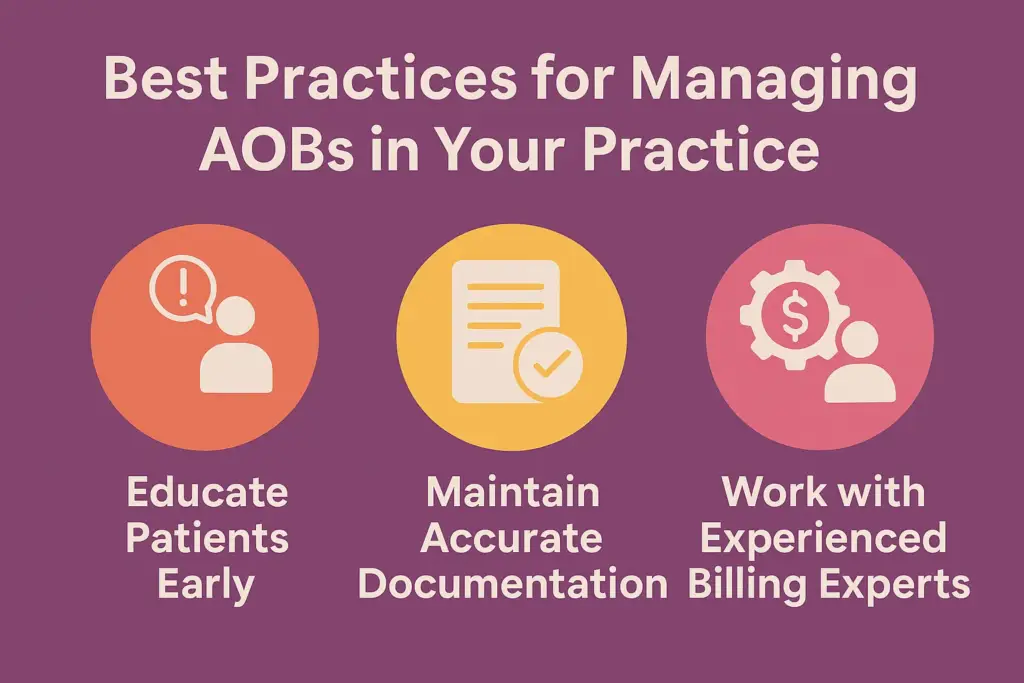In medical billing, AOB (Assignment of Benefits) refers to the patient’s written authorization that allows their insurance company to pay the healthcare provider directly. This simple form ensures that providers receive reimbursement without waiting for patients to forward payments. The Assignment of Benefits streamlines financial transactions, reduces confusion, and strengthens trust between patients and providers. For healthcare organizations, understanding what AOB is in Medical billing and how AOB works is essential to maintain steady cash flow, minimize claim delays, and ensure efficient reimbursement cycles.
Table of contents
Understanding Assignment of Benefits (AOB)
To manage claims effectively, healthcare providers must understand what the Assignment of Benefits actually means and how it functions within the billing process. AOB serves as the foundation for smooth insurance reimbursements, ensuring providers are compensated promptly for the care they deliver.
What Does Assignment of Benefits Mean?
The Assignment of Benefits (AOB) is a formal agreement between a patient and a healthcare provider. By signing this document, the patient grants permission to their insurance company to send payment directly to the provider instead of the patient. For example, if a patient visits a clinic for treatment, the provider bills the insurance company, and the insurer pays the clinic directly—thanks to the signed AOB. This eliminates the need for patients to manage complex billing or reimbursement tasks themselves.
How AOB Works in Medical Billing
The AOB process begins when a patient signs the Assignment of Benefits form during their visit. Here’s how it typically works:
- Patient Authorization: The patient signs the AOB, giving consent for direct insurer payments.
- Provider Submits the Claim: The healthcare provider submits a claim to the insurance company on the patient’s behalf.
- Insurance Company Review: The insurer reviews the claim, verifies coverage, and processes the payment.
- Direct Payment: Once approved, payment is sent directly to the provider, ensuring faster reimbursement.
This process involves three main stakeholders—the patient, who receives care; the provider, who delivers medical services; and the insurance company, which reimburses the provider. When managed properly, AOB enhances transparency, reduces administrative load, and speeds up the revenue cycle for medical practices.
Importance of AOB in Medical Billing
Understanding the importance of Assignment of Benefits (AOB) is crucial for every healthcare provider aiming to maintain consistent cash flow and reduce claim processing delays. A well-managed AOB ensures that payments are directed to the right place, helps practices avoid unnecessary administrative work, and strengthens the overall revenue cycle management process.
Ensures Direct Payments to Providers
One of the most significant advantages of the Assignment of Benefits is that it ensures direct payments to providers. When patients sign the AOB form, insurance companies send reimbursement directly to the healthcare provider instead of the patient. This direct payment structure eliminates waiting periods and prevents missed or delayed reimbursements. As a result, practices can manage their revenue more efficiently and reduce the risk of outstanding patient balances or cash flow interruptions.
Reduces Administrative Burden
Without AOB, practices would need to collect payments from patients after insurance disbursement, leading to time-consuming follow-ups and accounting challenges. With AOB in place, the insurer handles the payment directly, reducing paperwork, billing errors, and patient confusion. This approach simplifies the financial process for both sides—patients no longer worry about forwarding checks, and providers save time that can instead be dedicated to delivering quality care.
Improves Cash Flow and Financial Transparency
A well-structured AOB process supports better cash flow and financial transparency across the practice. Since insurers pay providers directly, payments are received faster and can be easily tracked through digital records. This consistency not only enhances financial visibility but also helps practices forecast revenue accurately. Moreover, incorporating AOB into your Revenue Cycle Management strategy allows your team to optimize claim processing, minimize denials, and maintain a healthy financial foundation.
Common Challenges with AOB Forms
While the Assignment of Benefits (AOB) process offers significant advantages for medical billing, it also comes with certain challenges that can affect payment timelines and claim accuracy. Incomplete documentation, patient errors, and insurer rejections are among the most common issues practices face. Understanding these challenges helps healthcare providers take proactive steps to prevent payment delays and maintain a smooth billing workflow.
Patient Misunderstanding or Incomplete Forms
A major challenge with AOB forms arises when patients misunderstand their purpose or fail to fill them out completely. Missing signatures, incorrect insurance details, or incomplete demographic information can lead to claim rejections or processing delays. For instance, if a patient forgets to sign the form or provides an outdated policy number, the insurer may suspend the payment until corrections are made. To avoid this, staff should take time to explain the importance of AOBs during registration and verify every detail before submission. Clear communication and double-checking forms can save days—or even weeks—of unnecessary claim rework.
Insurance Companies Denying AOBs
Another frequent issue is insurance companies denying AOBs due to policy restrictions or compliance errors. Some payers have specific rules regarding when and how AOBs are accepted. For example, certain insurers may reject AOBs if the patient’s consent isn’t dated or if the form doesn’t meet state or federal documentation standards. Additionally, errors in claim submission, such as mismatched patient identifiers or unverified coverage, can result in automatic denials.
To prevent these setbacks, practices should regularly review payer policies, ensure every AOB is accurately completed. Also, train billing staff to recognize insurer-specific requirements. Implementing these preventive steps not only reduces denial rates but also supports a more consistent and reliable revenue stream.
Legal and Compliance Considerations for AOB
The AOB is more than just a financial agreement—it’s also a legal document governed by both state laws and insurance regulations. Healthcare providers must understand these rules to avoid claim disputes or compliance penalties. Each state may have specific guidelines outlining how AOBs should be worded, signed, and stored, especially in cases involving third-party billing or out-of-network providers.
Insurance companies also impose their own requirements for accepting AOBs. Some may demand proof of patient consent, policy verification, or written acknowledgment of payment responsibilities. That’s why it’s essential to verify payer policies before billing. Doing so ensures your practice complies with both legal and insurer-specific rules, reducing the chances of claim denials or audits.
For accurate and up-to-date regulatory information, healthcare providers can refer to the Centers for Medicare & Medicaid Services (CMS) official site.
Best Practices for Managing AOBs in Your Practice
To get the most benefit from AOB forms, healthcare practices should follow consistent procedures that reduce errors and improve payment efficiency. These best practices help ensure accuracy, compliance, and faster reimbursements—three essentials for maintaining healthy revenue operations.
Educate Patients Early
Patient education is key to preventing delays and misunderstandings. Front desk teams should clearly explain why AOB forms are required and how they simplify payment processing. When patients understand that signing the form ensures their provider is paid directly, they’re more cooperative and less likely to make mistakes. Early education also builds trust and transparency in your billing process.
Maintain Accurate Documentation
Even minor documentation errors can disrupt reimbursement. Always verify that each AOB form includes complete, legible, and accurate details such as the patient’s name, insurance ID, policy number, and signature date. Keep all signed forms safely stored and easily accessible for audits or insurance reviews. Implementing digital documentation systems can further minimize manual entry errors and speed up verification processes.
Work with Experienced Billing Experts
Managing AOBs effectively requires deep knowledge of payer requirements and billing workflows. Partnering with professionals who understand these complexities can make a major difference in reducing rejections and improving cash flow. At Practice Perfect’s Medical Billing Service, our experts handle every step, from claim submission to reimbursement tracking, with precision and compliance in mind.

How Practice Perfect Helps with AOB and Billing Efficiency
Managing Assignment of Benefits (AOB) forms requires precision, compliance, and a deep understanding of payer policies. That’s where Practice Perfect stands out. Our team of medical billing professionals ensures every AOB is correctly documented, verified, and submitted to prevent delays and denials. With years of experience handling insurance claims, eligibility verification, and revenue cycle management, we help practices achieve faster reimbursements.
Final Thoughts
In today’s complex healthcare environment, understanding and managing AOB efficiently is essential for a seamless billing process. It ensures providers get paid on time, reduces patient confusion, and improves overall revenue stability. By partnering with a trusted billing team, your practice can focus on patient care while maintaining a strong financial foundation.
Talk to a Medical Billing Expert today to optimize your billing workflow and ensure faster reimbursements.
FAQs
The purpose of an Assignment of Benefits (AOB) form is to authorize the insurance company to pay the healthcare provider directly. This helps eliminate patient handling of reimbursements and ensures faster, more accurate payments to the provider.
The patient or policyholder signs the AOB form to grant permission for the provider to receive payment directly from the insurance company. In some cases, a legal guardian or authorized representative may sign on behalf of the patient.
Yes, insurance companies can refuse an AOB if it doesn’t meet their policy requirements, lacks a valid signature, or violates state regulations.
To avoid AOB-related denials, practices should verify payer rules, ensure forms are filled out completely, educate patients about the process, and work with experienced billing professionals.




